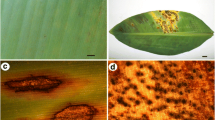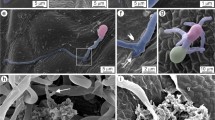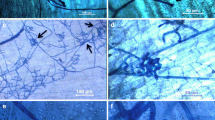Abstract
Macrospora leaf spot, caused by Stenocarpella macrospora, is an important disease of maize. However, little information is available regarding the infection process of this fungus on maize leaves. This study aimed to describe stages of the infection process of S. macrospora on maize leaves by using both light and scanning electron microscopy. The adaxial surfaces of maize leaves were inoculated with a conidial suspension of S. macrospora and leaf samples were collected from 24 to 96 h after inoculation (hai) and also at 20 days after inoculation (dai). At 24 hai, the germ tubes from the germinated conidia attempted to penetrate the leaf cuticle without any sign of positive tropism to stomata. After penetration, fungal hyphae colonized the epidermal cells as well as the underlying mesophyll cells. At 20 dai, prominent fungal growth was noticed in the phloem vessels, parenchyma cells, xylem vessels and in the bundle sheath cells as well as in the vessel elements. Fungal hyphae emerged in different developmental stages through the stomata and pycnidia were noticed in the necrotic lesions at 20 dai. These results provide new insight into the infection process of S. macrospora on maize leaves and may contribute to the development of more effective control of macrospora leaf spot.




Similar content being viewed by others
References
Babu AM, Philip T, Kariappa BK, Kamble CK (2009) Scanning electron microscopy of the infection process of Cercospora henningsii on cassava leaves. J Phytopathol 157:57–62
Bampi D, Casa RT, Bogo A, Sangoi L, Sachs C, Bolzan JM, Piletti G (2012) Fungicide performance on the control of macrospora leaf spot in corn. Summa Phytopathol 38:319–322
Beckman PM, Payne GA (1982) External growth, penetration, and development of Cercospora zeae-maydis in corn leaves. Phytopathology 72:810–815
Bensch MJ, Van Staden J, Rijkenberg FHJ (1992) Time and site inoculation of maize for optimum infection of ears by Stenocarpella maydis. J Phytopathol 136:265–269
Bradley CA, Pedersen DK, Zhang GR, Pataky NR (2010) Occurrences of diplodia leaf streak caused by Stenocarpella macrospora on corn (Zea mays) in Illinois. Plant Dis 94:1262
Brunelli KR, Athayde Sobrinho C, Cavalcanti LS, Ferreira PTO, Camargo LEA (2004) Germinação e penetração de Stenocarpella macrospora em folhas de milho. Fitopatol Bras 30:187–190
Cabanne C, Donéche B (2002) Polygalacturonase isoenzymes produced during infection of the grape berry by Botrytis cinerea. Vitis 41:129–132
Casa RT, Zambolim L, Reis EM (1998) Transmissão e controle de Diplodia em sementes de milho. Fitopatol Bras 23:436–441
Casa RT, Reis EM, Zambolim L (2003) Decomposição dos restos culturais do milho e sobrevivência saprofítica de Stenocarpella macrospora e Stenocarpella maydis. Fitopatol Bras 28:355–361
Casa RT, Reis EM, Zambolim L (2004) Dispersão vertical e horizontal de conídios de Stenocarpella macrospora e Stenocarpella maydis. Fitopatol Bras 29:141–147
Casa RT, Reis EM, Zambolim L (2006) Doenças do milho causadas por fungos do gênero Stenocarpella. Fitopatol Bras 31:427–439
CIMMYT (2012) Maize annual report: research program on Maize. CGIAR. p 28
Dai K, Nagai M, Sasaki H, Nakamura H, Tachechi K, Warabi M (1987) Detection of Diplodia maydis (Berkeley) Saccardo from imported corn seed. Res Bull Plant Protect Serv 23:1–6
Dean RA (1997) Signal pathways and appressorium morphogenesis. Annu Rev Phytopathol 35:211–234
Flett BC, Wehner FC, Smith MF (1992) Relationship between maize stubble placement in soil and survival of Stenocarpella maydis (Diplodia maydis). J Phytopathol 134:33–38
Have AT, Breuli WO, Wubben JP, Visser J, van Kan JAL (2001) Botrytis cinerea endopolygalacturonase genes are differentially expressed in various plant tissues. Fungal Genet Biol 33:97–105
Howard RJ, Valent B (1996) Penetration by the fungal rice blast pathogen Magnaporthe grisea. Annu Rev Microbiol 50:491–512
Jorgensen HJL, De Neergaard E, Smedegaard-Petersen V (1993) Histological examination of the interaction between Rhynchosporium secalis and susceptible and resistant cultivars of barley. Physiol Mol Plant Pathol 42:345–358
Kema GHJ, Yu D, Rijkenberg FHJ, Shaw MW, Baayen RP (1996) Histology of the pathogenesis of Mycosphaerella graminicola in wheat. Phytopathology 86:777–786
Kolattukudy PE (1985) Enzymatic penetration of the cuticle by fungal pathogens. Annu Rev Phytopathol 23:223–250
Kunoh H, Nicholson RL, Yosioka H, Yamaoka N, Kobayashi I (1990) Preparation of the infection court by Erysiphe graminis: degradation of the host cuticle. Physiol Mol Plant Pathol 36:397–407
Laluk K, Mengiste T (2010) Necrotroph attacks on plants: wanton destruction or covert extortion? The Arabidopsis Book, pp 1–34
Latterell FM, Rossi AE (1983) Stenocarpella macrospora (=Diplodia macrospora) and S. maydis (=D. maydis) compared as pathogens of corn. Plant Dis 67:725–729
Lobell DB, Cassman KG, Field CB (2009) Crop yield gaps: their importance, magnitudes and causes. Ann Rev Environ Res 34:179–204
Miles AK, Akinsanmi OA, Sutherland PW, Aitken EAB, Drenth A (2009) Infection, colonization and sporulation by Pseudocercospora macadamiae on macadamia fruit. Australas Plant Pathol 38:36–43
Mims CW, Vaillancourt LJ (2002) Ultraestructural characterization of infection and colonization of maize leaves by Colletotrichum graminicola, and by a C. graminicola pathogenicity mutant. Phytopathology 92:803–812
Movahedi S, Heale JB (1990) The roles of aspartic proteinase and endo-pectin lyase enzymes in the primary stages of infection and pathogenesis of various host tissues by different isolates of Botrytis cinerea Pers ex. Pers. Physiol Mol Plant Pathol 36:303–324
Nicholson RL, Yoshioka H, Yamaoka N, Kunoh H (1988) Preparation of the infection court by Erysiphe gramnis. II release of esterase enzyme from conidia in response to a contact stimulus. Exp Mycol 12:336–349
Prins TW, Tudzynski P, Tiedemann AV, Tudzynski B, Have A, Hansem ME, Tenberge K, van Kan JAL (2000) Infection strategies of Botrytis cinerea and related necrotrophic pathogens. In: Kronstad JW (ed) Fungal Pathology. Kluwer Academic Publishers, The Netherlands, pp 33–64
Van Kan JAL (2006) Licensed to kill: the lifestyle of a necrotrophic plant pathogen. Trends Plant Sci 11:248–253
Wharton PS, Julian AM, O’Connel RJ (2001) Ultrastructure of the infection of Sorghum bicolor by Colletotrichum sublineolum. Phytopathology 91:149–158
Wynn WK (1981) Tropic and taxic response of pathogens to plants. Annu Rev Phytopathol 19:237–255
Acknowledgments
Prof. F. A. Rodrigues thanks the CNPq for his research fellowship. The authors thank the “Núcleo de Microscopia e Microanálise” of the Universidade Federal de Viçosa” for the use of their equipment. We thank Dr. João Américo Wordell Filho for his technical assistance. This study was supported by grants from CAPES, CNPq and FAPEMIG to Prof. F. A. Rodrigues.
Author information
Authors and Affiliations
Corresponding author
Additional information
Section Editor: Elaine A. de Souza
Rights and permissions
About this article
Cite this article
Bermudez-Cardona, M.B., Cruz, M.F.A. & Rodrigues, F.A. Microscopic study of the Stenocarpella macrospora infection process on maize leaves. Trop. plant pathol. 41, 115–122 (2016). https://doi.org/10.1007/s40858-016-0079-3
Received:
Accepted:
Published:
Issue Date:
DOI: https://doi.org/10.1007/s40858-016-0079-3




